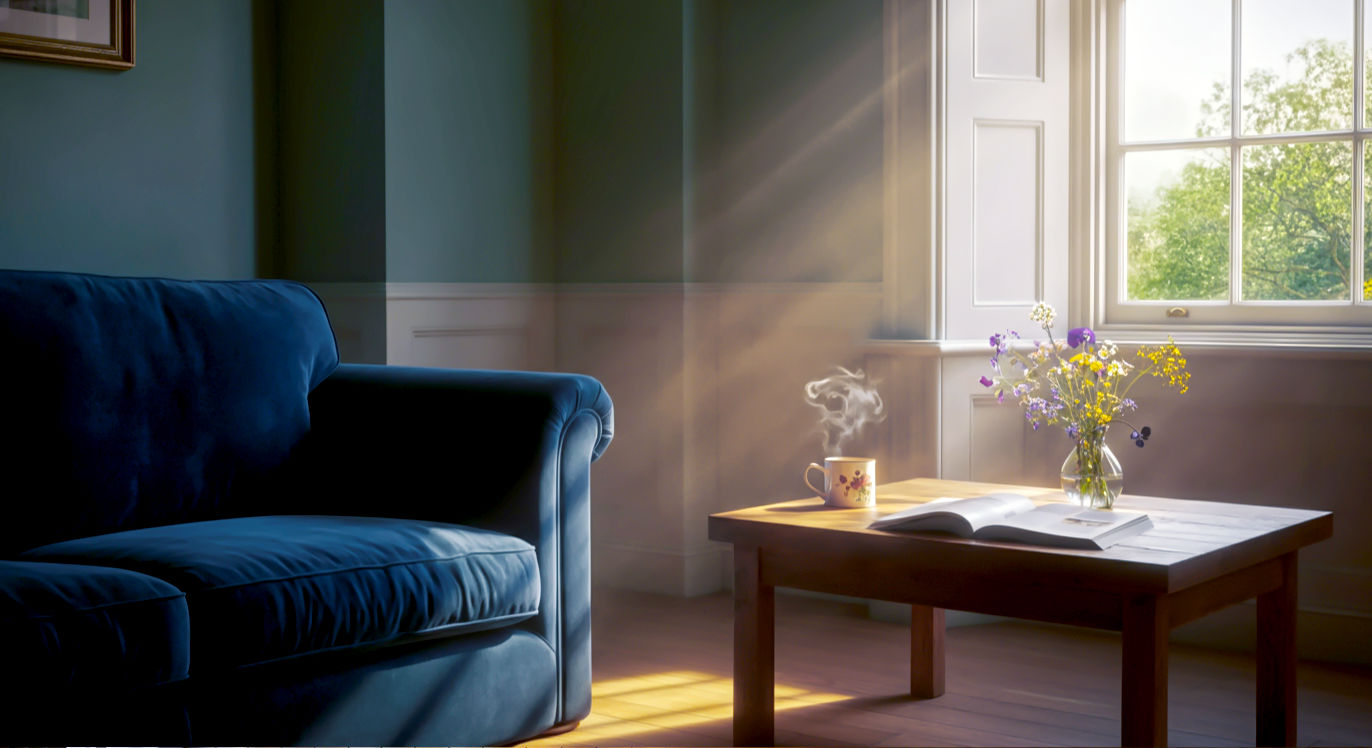The Guide to Design Psychology: How Your Home Shapes Your Mood and Behaviour
The ultimate guide to design psychology. Learn how the layout, colour, and light in your British home are constantly shaping your mood and behaviour.

This post may contain affiliate links. If you make a purchase through these links, we may earn a commission at no additional cost to you.
Ever walked into a room and felt instantly calm? Or stepped into another and felt a bit on edge for no reason you could name? It probably wasn’t just you. The chances are it was the room itself nudging your mood. This is the fascinating world of design psychology, the study of how our surroundings—from the colour of our walls to the height of our ceilings—quietly shape how we think, feel, and behave.
It’s not some mystical art; it’s a science that blends architecture, interior design, and human psychology. Think of it like this: your home is having a constant, silent conversation with your brain. The layout of your kitchen can encourage healthier eating, the lighting in your living room can bring your family closer together, and the clutter on your desk can drain your energy.
Here in Britain, where we spend so much of our time indoors (thanks, weather!), understanding this connection is more important than ever. From the snug layouts of our Victorian terraces to the sleek lines of modern city flats, our homes are the backdrops to our lives. By learning the secrets of design psychology, you can turn your space from just a place you live into a place that actively helps you thrive. This guide will walk you through everything you need to know, showing you how simple changes can make a world of difference to your well-being.
What Is Design Psychology, Really?
At its heart, design psychology is all about the link between our minds and the spaces we inhabit. It explores how things like colour, light, space, and texture trigger emotional and psychological responses. It’s the reason a spa feels relaxing and a library feels studious. Designers and architects use these principles to create environments that don’t just look good but feel right.
Think about a classic British pub. The low lighting, the warm wood, the cosy nooks—it’s all designed to make you feel comfortable, encouraging you to stay a while and chat with friends. That’s design psychology in action. It’s not about following fleeting trends; it’s about creating spaces that support our mental and emotional health.
The Core Pillars: What Makes a Space ‘Feel’ Right?
To really get to grips with how this works, we need to look at the building blocks of a room. These are the core elements that designers play with to influence our mood and actions.
1. Colour Psychology: More Than Just a Pretty Shade
Colour is one of the most powerful tools in a designer’s kit. Our brains are hard-wired to react to different colours, often in ways we don’t even notice. It’s a shortcut to our emotions.
- Warm Colours (Reds, Oranges, Yellows): These are colours of energy and excitement. Red can actually raise your heart rate, which is why it’s often used in fast-food restaurants to get people in and out quickly. In the home, a splash of orange in a kitchen can feel welcoming and stimulate conversation, but a whole bright yellow bedroom might feel a bit too much when you’re trying to sleep.
- Cool Colours (Blues, Greens, Purples): These shades are the calmers. Blue is known to lower blood pressure and create a sense of peace, making it perfect for bedrooms and bathrooms. Green, the colour of nature, is restful for the eyes and can help reduce anxiety. Think of a peaceful walk in the Peak District—that’s the feeling green brings indoors.
- Neutral Colours (Greys, Whites, Beiges): Neutrals are the versatile foundation. White can make a space feel clean, open, and spacious, which is why it’s a go-to for smaller British homes. Grey can be sophisticated and calming, though too much of it without texture or accent colours can feel a bit dreary—a bit like a wet Tuesday in Manchester.
A British Case Study: Farrow & Ball The massive popularity of heritage paint brands like Farrow & Ball in the UK isn’t just about quality paint. It’s about psychology. Their muted, complex colours like ‘Elephant’s Breath’ or ‘Hague Blue’ are sophisticated and calming. They tap into a desire for homes that feel like a sanctuary from the busy outside world, creating a sense of timeless, understated comfort that feels very British.
2. Light: The Natural Mood Booster
Light is just as crucial as colour. The amount and type of light in a room can dramatically affect our energy levels, mood, and even our sleep patterns.
- Natural Light: Our bodies are tuned to the rhythm of the sun. Big windows that let in lots of natural light can boost our mood, improve focus, and help us feel more connected to the outdoors. This is why conservatories and extensions with skylights are so popular in UK home renovations. Getting that morning light is particularly important for setting our internal body clock.
- Artificial Light: We can’t always rely on the British sun, so artificial lighting is key. The trick is to use ‘layered’ lighting.
- Ambient Light: This is the main source of light, like a ceiling fixture, that provides overall illumination.
- Task Light: This is focused light for specific activities, like a reading lamp by your favourite armchair or under-cabinet lights for chopping veg.
- Accent Light: This is used to highlight features, like a picture or a plant, adding depth and interest to a room.
The colour temperature of bulbs also matters. Warm, yellowish light is cosy and relaxing (great for living rooms), while cool, bluish-white light is better for concentration (ideal for a home office).
3. Space and Layout: The Flow of a Room
How you arrange furniture and navigate a room has a huge impact on how you feel in it. This is all about ergonomics and flow.
- Prospect and Refuge: This is a fascinating evolutionary idea. We feel safest in spaces where we have a clear view of our surroundings (prospect) while also feeling protected and enclosed (refuge). Think of sitting in a corner booth in a restaurant with your back to the wall, looking out. That’s the sweet spot. In your home, this might mean placing your sofa against a solid wall where you can see the door.
- Ceiling Height: High ceilings can make us feel free and creative, which is great for spaces where you want to brainstorm or socialise. Lower ceilings create a cosier, more intimate feeling, which works well for bedrooms or a snug. This is one reason why grand Victorian drawing rooms feel so different from a cosy country cottage.
- Clutter and Minimalism: Clutter is a modern-day enemy of calm. Our brains see clutter as unfinished business, and it can create a constant, low-level stress. Too much stuff overloads our senses. This doesn’t mean you have to become a strict minimalist, but having clear surfaces and good storage solutions can genuinely make you feel more in control and relaxed. As Marie Kondo famously asked, “Does it spark joy?” If not, it might just be adding to your mental load.
4. Texture and Materials: A Treat for the Senses
Design isn’t just about what we see; it’s about what we touch and feel. Texture adds depth and warmth to a space.
- Natural Materials: Wood, stone, wool, and linen connect us to the natural world. This concept, known as biophilia, suggests that we have an innate need to be close to nature. A chunky wooden dining table or a soft woollen throw can make a room feel grounded and authentic.
- Soft vs. Hard Surfaces: A room full of hard, shiny surfaces (glass, metal, polished concrete) can feel cold and echoey. Balancing these with soft textures—rugs, cushions, curtains—absorbs sound and creates a much more comfortable and inviting atmosphere. Think about the difference between a modern art gallery and your living room.
A Stroll Through British Design History
The way we design our homes didn’t just appear out of nowhere. It’s been shaped by centuries of history, technology, and cultural shifts. Understanding this journey helps us see why our homes look the way they do today.
From Tudor Halls to Georgian Grace
In Tudor times, a wealthy home was centred around the great hall—a large, open space for eating, socialising, and even sleeping. It was dark, often smoky, and not very private. Fast forward to the Georgian era (1714-1830), and things changed dramatically. Symmetry, order, and light became the guiding principles. The grand townhouses of cities like Bath and London were designed with large, elegant sash windows to let in as much light as possible. Rooms were given specific purposes—the dining room, the drawing room—creating a sense of privacy and structure that we still value today. This was the beginning of designing for psychological comfort and social status.
The Victorian Era: Cosy Clutter and Moral Design
The Industrial Revolution brought wealth to a new middle class, and the Victorian home (1837-1901) became a showcase for it. Victorians loved ornamentation, rich, dark colours, and heavy fabrics. Their rooms were filled with furniture, trinkets, and patterns. To us, it might look cluttered, but to them, it created a sense of warmth, security, and domesticity—a refuge from the harsh industrial world outside. There was also a moral dimension. Figures like William Morris and the Arts and Crafts movement rebelled against soulless, factory-made goods. They championed handmade craftsmanship and natural materials, believing that a well-designed home filled with beautiful, useful objects could improve one’s moral character.
The 20th Century: Modernism and Open-Plan Living
The 20th century saw a radical shift. Modernist architects like Le Corbusier declared that a house should be a “machine for living in.” Out went the clutter and dark corners, and in came clean lines, white walls, and open spaces. Function was king. This philosophy gradually filtered into mainstream British homes, especially after World War II. The desire for a brighter, healthier future led to the rise of open-plan living. Knocking down the wall between the kitchen and dining room wasn’t just a practical decision; it reflected a cultural shift towards more informal family life and entertaining.
Putting It All into Practice: Room by Room
So, how can you use these principles to make your own home a better place to be? Let’s take a tour.
The Living Room: A Hub for Connection
This is the heart of the home for many, a multi-purpose space for relaxing, socialising, and entertainment.
- Goal: Create a comfortable, welcoming, and flexible space.
- Layout: Arrange your seating to encourage conversation. Don’t just point everything at the telly! Place sofas and chairs facing each other, with a coffee table in the middle to anchor the space. Make sure there’s a clear path to walk through the room without bumping into things.
- Lighting: Layer your lighting. Have a main ceiling light, but also use table lamps and floor lamps to create soft pools of warm light in the evening. A dimmer switch is your best friend for changing the mood instantly.
- Colour and Texture: Use a calming, neutral base colour on the walls, and then bring in personality with colourful cushions, a patterned rug, or a vibrant piece of art. Mix textures—a soft velvet sofa, a chunky knit blanket, smooth wooden furniture—to make it feel rich and inviting.
The Kitchen: The Fueling Station
The kitchen is often the busiest room in the house. It needs to be practical, but it can also be a place of creativity and connection.
- Goal: Design an efficient, energising, and sociable space.
- Layout: The ‘work triangle’ is a classic design principle for a reason. It suggests that the sink, fridge, and cooker should form a triangle, making it easy to move between them. Good workflow is key to a low-stress kitchen. If you have space, an island or breakfast bar can turn the kitchen from a purely functional room into a social hub where family and friends can gather.
- Lighting: Good task lighting is essential. You need bright, focused light over your worktops, sink, and hob so you can see what you’re doing.
- Colour: Warm, cheerful colours like soft yellows or oranges can be great for a kitchen, stimulating appetite and conversation. But clean whites and cool greys can also work well, creating a sense of cleanliness and calm.
The Bedroom: Your Personal Sanctuary
This is your space to rest, recharge, and escape from the world. Its design should be all about promoting calm and restful sleep.
- Goal: Create a serene, restorative, and clutter-free environment.
- Layout: The bed is the star of the show. Ideally, place it against a solid wall where you can see the door from your pillow (that ‘prospect and refuge’ idea again). Keep the space around the bed as clear as possible.
- Colour: Soothing, cool colours are your best bet. Think soft blues, gentle greens, or muted lilacs. Avoid bright, stimulating colours like red or intense orange.
- Light: Blackout blinds or curtains are a must for blocking out streetlights and the early morning summer sun. Use soft, warm bedside lamps for reading rather than a harsh overhead light.
- Technology: This is a big one. The blue light from phones, tablets, and TVs can disrupt our sleep. Make your bedroom a tech-free (or at least a screen-free) zone for the hour before you go to sleep. Use a traditional alarm clock instead of your phone.
The Home Office: A Space for Focus
With more people working from home than ever, creating a dedicated workspace that promotes productivity is vital.
- Goal: Design a space that boosts concentration and minimises distractions.
- Layout: If you can, position your desk so you can see the door and have a view of a window. Facing a blank wall can feel stifling and uninspiring. Invest in an ergonomic chair and set your screen at eye level to avoid physical strain.
- Colour: Green is a great choice for an office, as it’s easy on the eyes and can aid concentration. Blues can also be productive. Avoid anything too distracting or chaotic.
- Biophilia: Bring some nature in! A couple of house plants on your desk or a nearby shelf can reduce stress and improve air quality. Research has shown that even looking at a picture of nature can improve focus.
Common Pitfalls and How to Avoid Them
It’s easy to get things wrong, but a few common mistakes are easily sidestepped.
- Ignoring Scale: A huge sofa crammed into a tiny living room will make the space feel cramped and stressful. Likewise, tiny furniture in a large room will feel lost. Before you buy, measure your space and mark out furniture dimensions with masking tape on the floor to get a real sense of its size.
- Poor Lighting: Relying on a single, harsh overhead light is one of the most common design sins. It casts unflattering shadows and makes a room feel flat and uninviting. Layer your lighting to create mood and functionality.
- Following Trends Blindly: That bright pink sofa you saw on Instagram might look amazing, but will you still love it in two years? Trends come and go. It’s better to invest in timeless, quality pieces for big items like sofas and beds, and use smaller, less expensive things like cushions and throws to experiment with trends.
- Forgetting About You: Ultimately, your home should be a reflection of your personality and a support for your lifestyle. Don’t create a perfect show home that you’re afraid to live in. If you love bright colours, use them! If you have a passion for books, make a feature of your bookcases. The most successful spaces are the ones that feel authentic to the people who live in them.
The Future of Design: What’s Next?
Design psychology is constantly evolving as we learn more about the brain and as our lifestyles change. Here are a few trends shaping the future of our homes.
- Sustainable and Healthy Homes: There’s a growing awareness of how our homes affect both our health and the planet’s. This means a move towards using non-toxic, natural materials, improving indoor air quality, and designing for energy efficiency.
- Designing for Neurodiversity: Architects and designers are beginning to think more about how to create spaces that work for everyone, including people with conditions like autism or ADHD. This might mean creating ‘quiet zones’ with low sensory stimulation or using specific colours and layouts that help reduce anxiety and improve focus.
- The Smart Home, But Smarter: The future of the smart home isn’t just about voice-activated lights. It’s about creating responsive environments. Imagine a home that can automatically adjust the lighting and temperature throughout the day to match your body’s natural circadian rhythm, helping you feel more energised in the morning and sleep better at night.
- Flexibility and Adaptability: Our lives are less rigid than they used to be. A home is no longer just a place to sleep and eat; it’s also an office, a gym, a school, and a cinema. Future designs will focus on creating flexible, multi-functional spaces that can adapt to our changing needs. Think movable walls, convertible furniture, and clever storage solutions.
Design psychology isn’t about rigid rules or expensive makeovers. It’s a way of thinking. It’s about being mindful of how your environment affects you and making small, intentional choices to create a home that not only looks great but genuinely supports your happiness and well-being. By understanding the silent conversation between you and your space, you can start to shape it for the better, turning the four walls you live in into a true sanctuary.
Further Reading
For those interested in delving deeper into the world of design psychology, here are some highly respected resources:
- The Royal Institute of British Architects (RIBA): A fantastic resource for cutting-edge architectural research, including studies on health and well-being in the built environment. architecture.com
- The Design Council: The UK’s national strategic advisor for design, offering insights into inclusive and sustainable design principles. designcouncil.org.uk
- Alain de Botton’s “The Architecture of Happiness”: A thoughtful and accessible book that explores the philosophical and psychological dimensions of the buildings we inhabit.
- Journal of Environmental Psychology: For a more academic perspective, this journal publishes peer-reviewed research on the interplay between humans and their physical surroundings.






